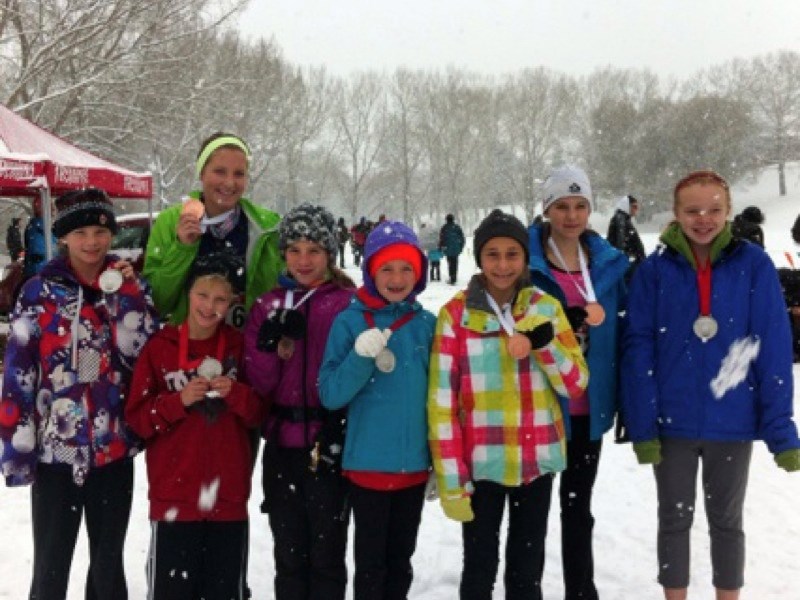Athabasca runners braved two or three inches of snow to bring home hardware from the Club Cross-Country Running Provincial Competition in Calgary Nov. 2.
Eight students — all girls — from Landing Trail Intermediate School (LTIS) competed.
“Maybe it’s the one sport right now where there’s more girls doing it than boys, and that’s excellent,” said Aspen View Schools associate superintendent Mark Francis, whose daughter Claire was on the LTIS peewee team and placed 10th individually.
The other peewee runners were Hailey Carouthers (9th), Renai Oltmanns and Ashlee May Prymak (both top 20 finishes). Those strong finishes netted the team a silver medal.
The bantam team consisted of Anna MacIsaac-Jones (sixth), Megan Lamoureux (13th), Jessica Meyer (15th) and Ayden Burger (28th), who won a team bronze.
“I think the typical pattern people see is there’s more boys in sports. That kind of seems to be the stereotype,” said Francis, noting that his experience coaching soccer has adhered to that gender distribution.
The LTIS cross-country coach, Joe MacIsaac, has a daughter on the bantam team, and that combined with Francis’s own daughter’s involvement may have something to do with the strong female interest locally, Francis acknowledged. Those two girls invite their friends to compete, and the sport’s popularity snowballs.
But strong female interest holds steady across the province, he maintained.
“There was easily as many girls running in the events as boys,” he said. “It is an equal representation sport, for sure.”
The LTIS students held their own against cross-country running teams from much larger centres from across Alberta, though Francis noted about half the competitors cancelled, likely due to the snow. Still, there were about 40 runners in each age category.
“The running in the snow and the running on the hills — that’s what our kids do here in Athabasca,” he said.
Francis said this the largest group coach MacIsaac has taken to the competition; next year, they hope to take 12 students.
He noted there is no provincial sports association in Alberta for grades below high school, so the club competition is younger students’ only opportunity to compete with a broad cross-section of runners.
“We entered as a school, but it’s not exclusive to schools,” said Francis, noting that many teams came from designated running clubs that train all year.
He said teams may have a maximum of six runners and a minimum of four.
“If you were a large club, you would bring six athletes. The top four scores become the team that you score on.”
Athabasca’s accomplishment was even more impressive given that each team had only four runners, so every score had to be counted.
“We were probably one of the smallest teams there,” he said. “For both teams to medal … I don’t think it was expected.”
Beyond the small team size, most of LTIS’s peewee runners were on the lower end of the age range.
“Grade 6 and below is the age group, and three of our kids were Grade 4s, so winning a silver medal when we have three Grade 4s running against kids who are two full years older — that’s really good.”
He noted some of the running clubs Athabasca competed against, such as the Edmonton Harriers Track & Field Club, produce national-calibre athletes.
Edwin Parr Composite student Jake Finney is part of the Harriers and also competed at club provincials; he placed fourth in the midget (ages 17 and 18) category.
“These are kids that go on to the scene and run for universities and so on, so getting fourth is exceptional,” said Francis.
Francis said the One Kilometre Club at LTIS — a noon-hour running club for the students — has been key to building a running culture in the school, and he credits vice-principal MacIsaac and teacher Jennifer Jones for their work.
“The future of running in Athabasca looks pretty strong, too,” Francis said. “Our hope is that this continues to be a trend.”



